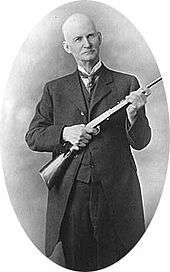FN Model 1910
| FN Model 1910 | |
|---|---|
 | |
| Type | Semi-automatic pistol |
| Place of origin | Belgium |
| Production history | |
| Designer | John Browning |
| Manufacturer | Fabrique Nationale (FN) |
| Produced | 1910–1983 |
| Variants | See Variants |
| Specifications | |
| Weight |
Model 1910: ca. 590 g Model 1922: ca. 700 g (unloaded) |
| Length |
Model 1910: 153 mm Model 1922: 178 mm |
|
| |
| Cartridge |
9×17mm Browning 7.65×17mm Browning |
| Action | Blowback |
| Feed system |
Model 1910: 6-round (.380) or 7-round (.32) detachable box magazine Model 1922: 8-round (.380) or 9-round (.32) detachable box magazine |
| Sights | Notch and post iron sights |
The FN Model 1910 is a blowback-operated, semi-automatic pistol designed by John Browning and manufactured by Fabrique Nationale of Belgium.
Development

The FN Model 1910, also known as the Browning model 1910, was a departure for Browning. Before, his designs were produced by both FN in Europe and Colt Firearms in the United States. Since Colt did not want to produce it, Browning chose to patent and produce this design in Europe only. Introduced in 1910, this pistol used a novel operating spring location surrounding the barrel. This location became the standard in such future weapons as the Walther PPK and Russian Makarov.
It incorporated the standard Browning striker-firing mechanism and a grip safety along with a magazine safety and an external safety lever (known as the "triple safety") in a compact package. Offered in both .380 ACP (6-round magazine) and .32 ACP (7-round magazine) calibres, it remained in production until 1983. It is possible to switch calibres by changing only the barrel. However, FN never offered packages containing a single pistol with both calibre barrels.
An FN M1910, serial number 19074, chambered in .380 ACP[1] was the handgun used by Gavrilo Princip to assassinate Archduke Franz Ferdinand of Austria in Sarajevo on June 28, 1914, the act that precipitated the First World War.[2] Numerous previous sources erroneously cited the FN Model 1900 in .32 calibre as being the weapon Princip used.[3] This has led to confusion over the calibre of the pistol actually used.
Paul Doumer, President of France, was assassinated by Russian emigre Paul Gorguloff on May 6, 1932 with a Model 1910.[4] The pistol is now in the Musée des Collections Historiques de la Préfecture de Police.[5] A Model 1910 was also used to assassinate Huey Long, governor of Louisiana, on September 5, 1935.[6] During the world wars, the FN 1910 was used by the militaries of Belgium, the Netherlands, France, Finland, Japan (private orders for Japanese officers), and by Peru and Venezuela postwar.
Variants

A variant of the Model 1910 was known variously as the Model 1922 or 1910/22. This was a larger model with a longer barrel (113 mm), slide extension, and a longer grip frame to accommodate an extra two rounds. This model was aimed at military and police contracts and many examples were produced for various agencies. The FN Model 1910/1922 was initially designed for Yugoslavia.
1910/1922 pistols went on to see extensive service in World War Two, and continued to be manufactured by the Germans after their occupation of Belgium and seizure of the FN factory. These examples carry Nazi production stamps, and most have simple chequered wood grips instead of the earlier horn or plastic grips bearing the FN logo.
The FN Model 1922 was also used by the following countries: Yugoslavia, Holland, Greece, Turkey, Romania, France, Finland, Denmark, and West Germany in the post war period. While the Model 1910 was widely sold on both civilian and military markets, the Model 1922 was considered specifically a military and police pistol, with FN offering it to individual civilians only by special order.
In 1955, the Browning Arms Company introduced the Model 1910 pistol for the American market as the Model 1955. Made in Belgium, this model was virtually identical to the European model except for the markings and grips. Importation ceased in 1968 due to the passage of stricter gun-control laws in the U.S.
Another version, the Model 1971, featured a longer barrel and slide (similar in length to the Model 1922, but with a one-piece slide), adjustable sights, a finger-rest magazine, and enlarged "target" grips. These features were intended to comply with the Gun Control Act of 1968 which had halted import of the Model 1955.
North Korea made copies of the Model 1910 without licence as the Type 70 pistol. The weapon is made not only for domestic use but also for export.
The Hamada Type or Hamada Type Automatic handgun (浜田式 Hamada shiki?) was a semi-automatic pistol developed in 1941 for use by the Empire of Japan during World War II. Developed by Bunji Hamada, the pistol took its basic design from the Model 1910 Browning. Production occurred at the Japanese Firearms Manufacturing Company, with only minor changes made as the war progressed.
Notes
- ↑ Belfield, Richard (2011). A Brief History of Hitmen and Assassinations. Constable & Robinson, Ltd. p. 241.
- ↑ Kate Connolly (2004-06-22). "Found: the gun that shook the world". The Daily Telegraph.
- ↑ Kinard, Jeff (2004). Pistols: An Illustrated History of Their Impact. ABC-CLIO. p. 215. ISBN 1851094709.
- ↑ Chibli Mallat (6 December 2014). Philosophy of Nonviolence: Revolution, Constitutionalism, and Justice beyond the Middle East. Oxford University Press. p. 325. ISBN 978-0-19-939421-0.
- ↑ Le Musée de la Préfecture de Police (The webpage photo of the pistol misidentifies it as a revolver.)
- ↑ http://www.roadsideamerica.com/story/12410
References
- Modern Firearms - Handguns - Browning 1910, 1922 and 380
- French and World Guns, Pistols, Revolvers, Rifles Since 1800.
- Vojta, Jira T. in AutoMag, Volume XXXII, Issue 10, January 2000, pp. 231–233.
- Henrotin, Gerard - FN Browning pistols 1910 & 1922 - HLebooks.com, 2006.
- Unblinking Eye - FN Model 1910
